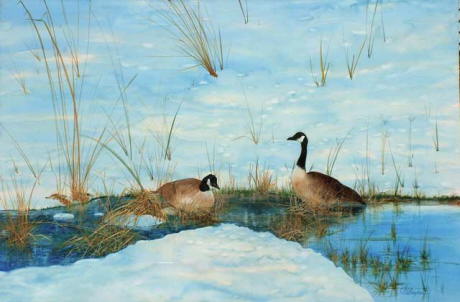Watercolor on Canvas
By Mary Ann Boysen
Winter Feeding Ground was perhaps my most bold undertaking as the size is 40” x 60”, unusually large for a watercolorist painting on watercolor canvas.
Because the canvas does not absorb the paint I could not slant the canvas too much or the paint would have been at my feet within minutes! I had to piece together two large pieces of Gatorboard to lay the stretch canvas against, and place it on an easel that could be adjusted for slant. |
Painting on Watercolor Canvas
Landscapes
Horizons |
This easel was placed on a table, so that I could stand up and work much like anoi-painter, but bending over a bit because of the slant.

I wanted the snow to remain transparent so I began with my usual “three-wash” beginning. Starting with Quinacridone gold over the wet canvas, then applying a wash of Opera, then Cobalt Blue hue. The blue was not allowed to run as much so I dried the first two color wash before the blue was applied. That way I could save the dimples in the snow that were high lighted by the afternoon sun.
I then started with the geese to get the medium values into the painting. I am not a detailed bird painter and didn’t really want to paint every feather on the birds, but I tried to get as much detail as possible without going too far.
When painting on watercolor canvas, I have found that when you need fine detail, you must allow the canvas to dry completely….probably for several hours, as the grain of the canvas holds onto the water more than watercolor paper.
So I began working on the spring water that had remained melted at the bottom of the hill, with the marsh grasses protruding. In the grasses area, I utilized negative painting, and even adding a bit of Permanent White Gouache to my colors for an opacity that I needed to complete the grasses.
It took several washes of dark color to get the water dark enough to be a contrast to the body of the geese, yet creating some reflection of their bodies in the water.
To break up the vast area of snow, I painted in tall grasses coming out ofthe snow. I had to get beside the painting when it was laying almost flatand create the brush strokes with large arm movements to keep them assmooth as possible. This was NOT easy!
Then I went back to the geese to put on the final details.
In my side yard, where this scene exists, there is a black split-level fence, but I chose not to paint it in, as I felt it would draw the eye away from the geese. Perhaps I was mistaken, as some people don’t understand that the white in the background is snow and not sky. Maybe someday, I will take acrylic paint and put at least part of the fence there. It will have to be done with acrylic, as this painting has been sealed with a spray that will repel watercolor.
Since this painting is so large, it looks great unframed, as I painted around the deep edges to create the “gallery wrap” which is so popular these days. I can actually lift this painting with ease because the watercolor canvas and its stretcher bars are light weight. It hangs in a room with skylights and there is no glare on the surface because there is no glass over it. For UV protection, GOLDEN makes watercolor varnish that I highly recommend for the final finish.

You can also see the 20 videos of mine on YOUTUBE
Return to Watercolor Techniques
Take a look at the Painting Lessons
Return to Watercolor Painting Tips Home
Painting on Watercolor Canvas
Landscapes
Horizons
|

